Heat pump cycle system
- Summary
- Abstract
- Description
- Claims
- Application Information
AI Technical Summary
Benefits of technology
Problems solved by technology
Method used
Image
Examples
first embodiment
Next, operation of the heat pump cycle system according to the present invention will be now described.
(1) Cooling Operation
During the cooling operation, as shown in FIG. 3, refrigerant discharged from the compressor 10 is cooled in the outside heat exchanger 20, is decompressed in the expansion valve 50, is evaporated in the inside heat exchanger 30 by absorbing heat from air in the air conditioning case 33, and is sucked into the compressor 10 after passing through the accumulator 80. Therefore, air passing through the inside heat exchanger 30 is cooled during the cooling operation. In this case, pressure of refrigerant (i.e., high-pressure side refrigerant) on an outlet side of the outside heat exchanger 20 is controlled by the expansion valve 50 based on the temperature of refrigerant on the outlet side of the outside heat exchanger 20, detected by the first temperature sensor 61.
Here, the control of the expansion valve 50 will be now described in detail based on the flow diagra...
third embodiment
FIG. 14 is a schematic view showing a CO.sub.2 refrigerant cycle of a heat pump cycle system according to the As shown in FIG. 14, the second temperature sensor 64 described above is omitted, and a fifth temperature sensor 68 is disposed to detect the temperature of refrigerant flowing in a refrigerant pipe 34 connecting the refrigerant outlet side of the first inside heat exchanger 31 and the refrigerant inlet side of the second inside heat exchanger 32.
Here, the control of the expansion valve 50 according to the third embodiment will be now described based on the flow diagram shown in FIG. 15. Firstly, at step S400, refrigerant temperature detected by the first temperature sensor 61 is input during the cooling operation or refrigerant temperature detected by the fifth temperature sensor 68 is input during the heating operation. Next, at step S410, a target pressure is determined based on the relationship between the refrigerant temperature and the refrigerant pressure, shown in F...
fourth embodiment
An initial load of the coil spring 620 is adjusted by a spacer 621, so that a predetermined initial load applied to the valve body 618 is adjusted by the spacer 621. In the present invention, the initial load of the coil spring 620 is about 1 MPa when being calculated by the pressure of the diaphragm 611.
FIG. 18 is a schematic view of the mechanical expansion valve 500. The structure of the expansion valve 500 is similar to that of the expansion valve 600, except for the refrigerant passage 602 forming a part of the refrigerant pipe 34. That is, as shown in FIG. 18, a sealed space 512 is formed by a spherical-surface valve cover 510 and a diaphragm 511. CO.sub.2 refrigerant is sealed within the sealed space 512 by a density of about 600 kg / m.sup.3 when a valve port 517 is closed. A refrigerant inlet side space 514 and a refrigerant outlet side space 515 of the expansion valve 500 are partitioned by a partition wall portion 516, and a valve port 517 through which both spaces 514, 515...
PUM
 Login to View More
Login to View More Abstract
Description
Claims
Application Information
 Login to View More
Login to View More - R&D
- Intellectual Property
- Life Sciences
- Materials
- Tech Scout
- Unparalleled Data Quality
- Higher Quality Content
- 60% Fewer Hallucinations
Browse by: Latest US Patents, China's latest patents, Technical Efficacy Thesaurus, Application Domain, Technology Topic, Popular Technical Reports.
© 2025 PatSnap. All rights reserved.Legal|Privacy policy|Modern Slavery Act Transparency Statement|Sitemap|About US| Contact US: help@patsnap.com



